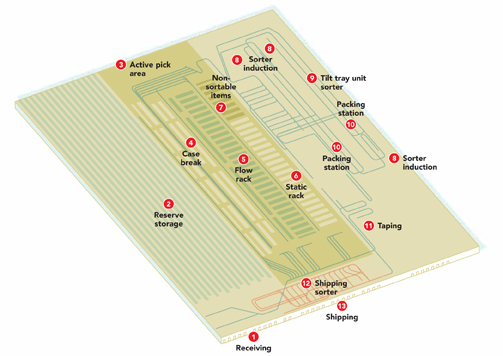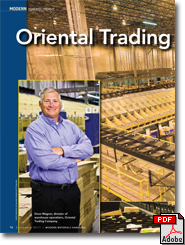Oriental Trading’s explosive order fulfillment
Oriental Trading’s unique picking solution handles up to 400,000 items per day.
Latest Logistics News
April Services PMI contracts after 15 months of growth, reports ISM 2023 industrial big-box leasing activity heads down but remains on a steady path, notes CBRE report U.S. rail carload and intermodal volumes are mixed in April, reports AAR Q1 U.S. Bank Freight Payment Index sees shipment and spending declines Pitt Ohio exec warns Congress to go slow on truck electrification mandates More NewsOriental Trading Company
LaVista, Nebraska
Size: 750,000 square feet, including 500,000 square feet of storage and 250,000 square feet of fulfillment; OTC operates a second 600,000-square-foot facility in Omaha
Products handled: Party supplies, arts and crafts, toys and novelties
Stock keeping units: 30,000
Units handled: 78 million units handled in 2010 with up to 404,000 on peak days
Employees: 750 to 1,100 depending on the season
Shifts/Days: 3 shifts/5 days with occasional sixth day during peak periods
To fill orders, associates send thousands of items to a unique tilt tray sorter that then assembles the orders at the packout stations.
Receiving: Inbound containers are floor-loaded and typically contain 30 to 40 different items. At the receiving dock (1), containers are unloaded and cases are sorted to pallets by item number. Once a pallet is full, a license plate bar code is applied to the pallet and scanned to update inventory in the warehouse management system (WMS). Each product is then inspected in a quality assurance area, and weighed and measured at both the selling unit and case level. That information is used later in a packaging algorithm that selects the right box for an order as well as for calculating the weight and cube for rate shipping.
Putaway: There are more than 100,000 pallet locations in the reserve storage area (2). pallets are staged in a putaway and drop (P&D) location at the end of each aisle, based on the final putaway location that was selected by the WMS. A turret truck operator is directed by an RF device to the P&D location to retrieve the pallet and deliver it to a storage location. Inventory is tracked by the license plate tag and scans from location to location. Both turret trucks and orderpickers operate on a wire guidance system in reserve storage.
Replenishment: After an allocation is run, the WMS determines how many cases of each item need to be delivered to the active pick area (3). Cases can be put away in a case break area (4); flow rack area (5); and a static rack area (6) on a min/max system; and determines which cases need to be pulled for fulfillment of case lot orders from the rack picking area (2). These picks are then placed into a replenishment pick queue. Drivers are allocated work from the queue based on the profile that they are set up in. Profiles can include specific aisles, equipment types and priorities. Drivers are then directed to a location and pick a specific number of cases for an item. They apply identification labels to the cases and scan these labels to associate a case with a carton identifier.
Upon completing work in the queue or filling an order picker bed, the cases are taken to one of two takeaway conveyors. The cases are then conveyed to the active pick area (3) where they will be sorted on a belt sorter with divert arms to staging destinations within the active pick area, or to a case lot meter area where the cases will be shipped. As cases arrive in the staging destinations, stockers use RF devices to move the cases to active pick locations.
Picking: Pickers within the active pick area (3) process picks to fill a 100,000 unit wave. Each wave is broken down into four subwaves and a total of 16 sorts. Items can be picked from four areas: case break (4), flow rack picking (5), static rack picking (6) and non-sortable picking (not illustrated). Each of these pick methods is directed by the voice recognition system.
In the case break area (4), the entire contents of a full case will be consumed within a wave. The picker is directed to scan a case label on the case and then scan the UPC code from one item within the case. The voice system will then communicate to the picker which totes to place the items into. The case contents are placed into totes that are set up within a put module that has a location for each subwave and induction platform (8).
As the picker places items and quantities into the tote, they validate the pick by speaking a check digit for the location within the put module that the tote is in.
In the flow rack area (5), a picker is directed to a pick location and then to place picked units into totes that are set up on put carts. The picker verifies that he is at the right location by communicating the check digit that is associated to the location. The picker is then directed to pick a specific quantity of units and place them into the appropriate totes within the module on their cart.
In the static rack area (6), pickers also pick to a cart. Each picker will make two passes per wave in the static area. As totes become full of product, the picker stages the totes on staging conveyor and replaces that tote with an empty tote on the put cart. In addition, the pickers will stage totes on the staging conveyor when they complete a wave. As work is needed on the sorter the pickers are directed by the voice system to release totes from the staging conveyor to the takeaway conveyor that will convey totes to the appropriate induct platform (8) on the unit sorter (9).
Products that can’t be placed on the unit sorter due to size or fragile nature are picked in a process similar to the static area process but are not staged on staging conveyor. Non-sortable products are delivered to the pack area (10) at the appropriate time.
Induct and sort: Totes from the pick area are conveyed to a tote sorter where they are sorted to one of the four induction platforms (8) on the unit sorter (9). Each induction platform has eight induct stations. The induct operators will each have totes directed to their station. The induct operator will then scan the tote, scan an item in the tote and place the item on the next available tray on the sorter.
The system displays how many of an item should be left in the tote and will count down that quantity on the screen as items are placed on trays. The inductor will continue inducting items until the tote is empty. As items are inducted, the unit sorter directs them to the appropriate pre-determined packout destination (10) for an order that requires that item.
Packing: The facility features 600 chutes, or packout destinations (10). Up to 12 orders can be assigned to each chute depending on the cube of the order. Once all of the orders assigned to a chute have been sorted, the packer scans the chute and is directed to set up a box for each order. The packer then scans each item and is directed to place the item into the appropriate box on the packout table. Once all the items in the chute are scanned, the packer will retrieve any non-sortable items that are needed for those orders and place them into the appropriate box. Finally, the packer will place the shipping label on the box, insert the packing slip and place the box on the takeaway conveyor. The takeaway conveyor routes the package to the pillow tape area (11) where bio-degradable air pillows are inserted for dunnage and the package is sealed. The package is then sorted (12) to shipping (13).
Shipping: Packages are routed to the shipping conveyor where they pass through one of two inline scales and overhead scanners. Each package is weighed and the order number/package ID is scanned to close the order and create a carrier manifest. The shipping sorter (12) then diverts the package down the appropriate chute based on carrier/service level and destination of the package.

System Report: Oriental Trading Company gets its warehouse under control
The large, direct-to-consumer retailer’s new warehouse relies on a sophisticated warehouse control system to pick up to 400,000 items a day.
System suppliers
System design, integration and warehouse control system: W&H Systems
WMS: Interlink Technologies
Conveyor/tilt tray sortation: Beumer
Conveyor/sortation: Intelligrated
Voice recognition technology: Lucas Systems
Picking rack and mezzanine: Unarco Material Handling
Pallet racking: Interlake Mecalux
Lift trucks: Crown Equipment Corp.
Bar code scanning: Motorola Solutions
Radio Frequency system: Psion

Article Topics
Latest in Logistics
April Services PMI contracts after 15 months of growth, reports ISM 2023 industrial big-box leasing activity heads down but remains on a steady path, notes CBRE report U.S. rail carload and intermodal volumes are mixed in April, reports AAR Q1 U.S. Bank Freight Payment Index sees shipment and spending declines S&P Global Market Intelligence’s Rogers assesses 2024 import landscape Pitt Ohio exec warns Congress to go slow on truck electrification mandates Q1 intermodal volumes are up for second straight quarter, reports IANA More LogisticsAbout the Author
About the Author
Subscribe to Logistics Management Magazine

Find out what the world's most innovative companies are doing to improve productivity in their plants and distribution centers.
Start your FREE subscription today.
May 2024 Logistics Management

Latest Resources















